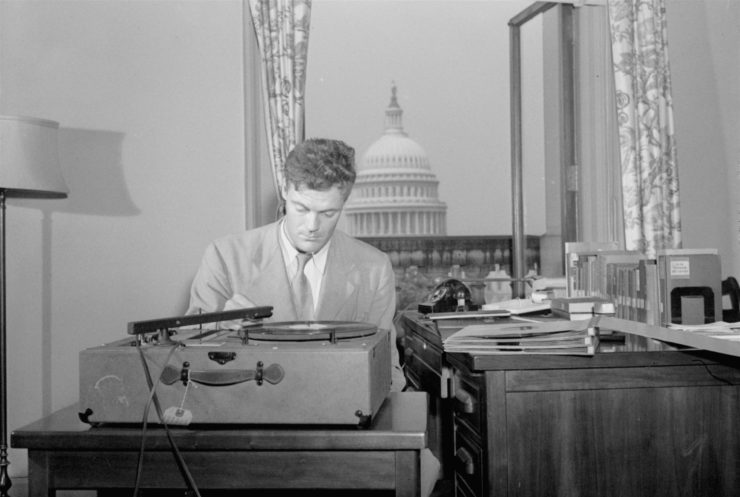
Writer Robert Lowell, Jr., who was the Library of Congress consultant in poetry in English, listens to a playback of a new recording of poetry in his office in Washington in 1948.
It was Poetry Week on Storyboard, which is pushing the envelope a bit for a site that explores the art and craft of narrative nonfiction. But I would argue that literary journalists can learn a lot from poets, especially their economy of form, where every word, every beat of the tempo, every pause counts. And no less than Percy Bysshe Shelley (see the One Great Sentence below) offers an explanation of poetry that applies to journalism too.
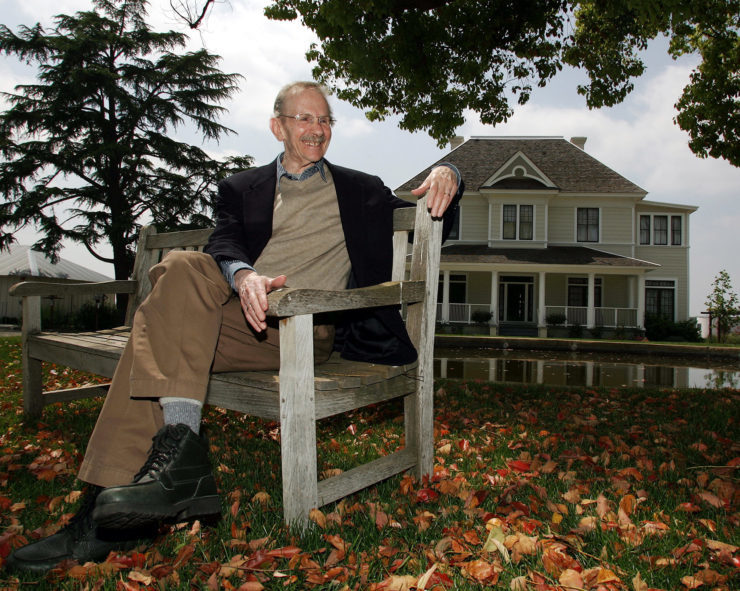
This 2006 file photo shows poet Philip Levine in Fresno, Calif.
Finding lessons for literary journalism in the poetry of Rust Belt chronicler Phil Levine. I love this post by my old Los Angeles Times colleague Tom Curwen. In it, he makes a persuasive case for how poetry helps him in his journalistic writing. Levine, he writes “was a storyteller above all, spinning his yarns in stanza-less poems, blocks of type that are always neatly measured, briskly paced and almost cinematic in a precision of detail that would embarrass the most economic writer.” He goes on: “He erased the distance between himself and his subject and exercised an identification with people and places that brings to mind some of the most memorable pieces of literary journalism (think Michael Lewis or Susan Orleans). Rather than tell the story at an arm’s length, he enters each moment completely, following the simple maxim that the more intimately you render the world, the more universal its meaning.”
The soundtrack: “Wrecking Ball,” by Bruce Springsteen. Perhaps predictably I chose (poet) Bruce Springsteen as a Phil Levine soulmate. I could have picked a dozen songs, but this lyric seemed to fit: “Now when all this steel and these stories, they drift away to rust/And all our youth and beauty has been given to the dust/The game has been decided, and we’re burning down the clock/And all our little victories and glories, have turned into parking lots/When your best hopes and desires are scattered to the wind/Hard times come, hard times go.”
One Great Sentence
“Poetry lifts the veil from the hidden beauty of the world, and makes familiar objects be as if they were not familiar.”
Percy Bysshe Shelley, from “A Defence of Poetry and Other Essays”
Read why we think it’s great.
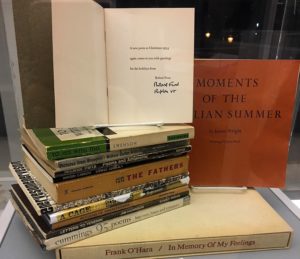
A display at The Poets House in New York.
Poetry finds a (calming) home in the hurly-burly of 21st century New York. Not far from the high-finance hustle of the World Trade Center, contributor Jasmine Bager stumbled across an oasis of poetry: the Poets House, which for three decades has served as a library of this “old-fashioned” art. Longtime director Lee Briccetti, argues that poetry plays a vital role in our society, saying, “Art helps to keep us and our democracy healthy, by circulating ideas and real information about how we live, from across the world and through the ages.” And I love the kicker to the story. Jasmine writes, I had to ask—why wasn’t it called the Poet’s House? An intern at the entrance cheerfully told me that it didn’t have an apostrophe in the name because “poetry belongs to everyone, not just to us.”
The soundtrack: “Poet,” by Sly & the Family Stone. Who can ask for more — a great groove and lyrics like these? “My only weapon is my pen/And the frame of mind I’m in/I’m a songwriter/A poet/I’m a songwriter/A poet/And the things I flash on everyday/They all reflect in what I say.”
What I’m reading online: Let’s start with the poetry that The New Yorker publishes in every issue, and archives online. When I followed the magazine’s “poetry bot” on Twitter, it sent a Dorothy Parker poem that seemed meant just for me, about the desire to escape the city for the country (with a classic Parker kicker that deflates those romantic dreams).
Sticking with Twitter, reporter Pamela Colloff tweeted about the stellar work that reporters in “flyover country” are doing, and asked for people to reply with their favorite reporters or stories. Writer Ted Genoways (whom we spotlighted recently) said the story that haunts him most this year is the one he reported from a Kansas meatpacking town, “The Only Good Muslim Is a Dead Muslim.” This New Republic piece about a plot to kill Somali immigrants is terrifying. Especially this quote, told by one of the plotters to an undercover agent: “There’s no leaving anyone behind, even if it’s a one-year-old,” Stein said. “I’m serious. I guarantee if I go on a mission those little fuckers are going bye-bye.”
After that, I needed something to get the metallic taste of anger out of my mouth. Thank you, BBC Future, for this one: “The fascinating reason why clowns paint their faces on eggs,” by Dave Fagundes and Aaron Perzanowski. I know clowns are always good for a queasy laugh, but this piece by two legal researchers goes high, even when the laughs are inherent.
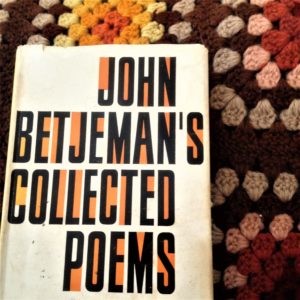 What’s on my bedside table: “John Betjeman’s Collected Poems,” by John Betjeman. He’s much better known in England, where he was poet laureate in the 1970s. He was a bit cranky, and often wrote about the old-fashioned English things that he feared were slipping away: the countryside, old buildings, the everyday comforts of a middle-class life. In one, about the unlovely London suburb Slough, he writes, “Come, bombs, and blow to smithereens/Those air-conditioned, bright canteens/Tinned fruit, tinned meat, tinned milk, tinned beans/Tinned minds, tinned breath.”
What’s on my bedside table: “John Betjeman’s Collected Poems,” by John Betjeman. He’s much better known in England, where he was poet laureate in the 1970s. He was a bit cranky, and often wrote about the old-fashioned English things that he feared were slipping away: the countryside, old buildings, the everyday comforts of a middle-class life. In one, about the unlovely London suburb Slough, he writes, “Come, bombs, and blow to smithereens/Those air-conditioned, bright canteens/Tinned fruit, tinned meat, tinned milk, tinned beans/Tinned minds, tinned breath.”
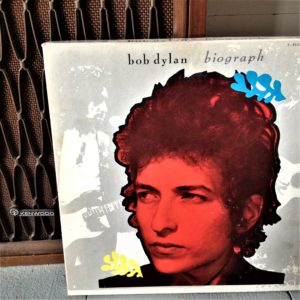 What’s on my turntable: “Biograph,” by Bob Dylan. For Poetry Week, I had to pick Dylan, our Nobel-winning lyricist/poet. (For all those who were upset when he won the prize, I urge you to look at the lyrics sheet to just about any of his albums and tell me they’re not poetry, and prose, and yes, even biography.) And the bonus to this box set are the epic liner notes by Cameron Crowe. They’re a longform love letter to Dylan, his life and what he has created. He opens by talking about a costume party a friend had gone to where everyone was asked to dress as a character from a Dylan song. “The party was a great success. What a compliment, I remember thinking, and what a sparse gathering this event might have been in the hands of most other artists.”
What’s on my turntable: “Biograph,” by Bob Dylan. For Poetry Week, I had to pick Dylan, our Nobel-winning lyricist/poet. (For all those who were upset when he won the prize, I urge you to look at the lyrics sheet to just about any of his albums and tell me they’re not poetry, and prose, and yes, even biography.) And the bonus to this box set are the epic liner notes by Cameron Crowe. They’re a longform love letter to Dylan, his life and what he has created. He opens by talking about a costume party a friend had gone to where everyone was asked to dress as a character from a Dylan song. “The party was a great success. What a compliment, I remember thinking, and what a sparse gathering this event might have been in the hands of most other artists.”
If you want to chat about storytelling (or music), I’m Storyboard editor Kari Howard, and you can reach me at editor@niemanstoryboard.org. Or you can find me at @karihow on Twitter.


